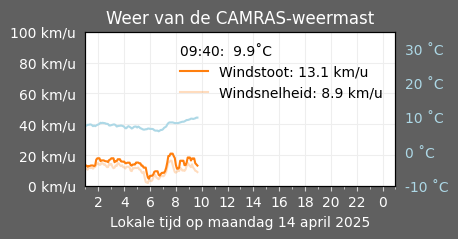Restoration
Subsidies and sponsor contributions
After the Dwingeloo Radio Telescope became a national monument, ASTRON, owner of the monument, was able to request subsidy from the National Cultural Heritage Agency and other subsidy providers to restore the telescope thoroughly. The restoration was made possible with contributions from:
- National Institute for Cultural Heritage (RCE)
- Netherlands Organization for Scientific Research (NWO)
- Province of Drenthe
- Municipality of Westerveld
- VSB Fund
- SNS Reaal Fund
- Rabobank Southwest Drenthe.
Realization
On behalf of ASTRON, Holstein Restauratie Architectuur from Groningen drew up the restoration plan. The philosophy of the restoration was that at the end of the restoration process, there would be a top instrument once more that subsequently could be used properly again. MultiPaint from Stadskanaal won the tender for main contractor. Under supervision of ASTRON project manager Peter Bennema, the following companies realized the restoration:
- Holstein Restauratie Architectuur (Groningen) (management)
- Multipaint steel preservation (Stadskanaal) (main contractor)
- Oving special products (Gasselte)
- Wever Construction (Onstwedde)
- Machine factory Rusthoven (Groningen)
- Brandsma Digital Measurement (Bolsward)
- Frans Nooren (Stadskanaal)
- Brands Bouwgroep (Emmen).
As ASTRON and CAMRAS have a lot of specialist knowledge about the Dwingeloo Radio Telescope, they co-operated well with the companies during the restoration.
Two years until the reopening
The restoration lasted almost two years: from April 28, 2012, when councilor Anry Kleine Deters of the municipality of Westerveld symbolically unplugged the radio telescope after an ‘open day’, until the reopening on April 5, 2014, when astronomer, radio amateur and Nobel Prize winner Joe Taylor put the Dwingeloo Radio Telescope in motion again with a symbolic push on the button. By far the most spectacular moments of the restoration process were lifting the mirror on June 5, 2012, and replacing it on November 19, 2012.
The mirror is stuck
For more than 50 years, the mirror with an estimated weight of 30 tons was suspended in the tower. Under the watchful eye of the present media (television, radio and many newspapers), the mirror would be lifted of the tower and be placed on a separate trestle at 2 p.m. sharp. While the audience was at a safe distance from the telescope, the crane was working and the workers were walking back and forth. Despite a lot of banging and creaking, nothing happened until the crane driver stopped. The maximum lifting load had been reached and the mirror was still stuck. Apparently, the dish had become heavier than the estimated 30 tons due to all the changes over the years. To prevent the crane from falling over, it had to be counterweighted with additional weights.
On a second attempt in the evening, with the counterweighted crane and again a lot of banging and creaking, the mirror got moving. Swaying at the cables, the dish was stuck behind a fence that could be removed with a sawing tool. And after a stately gliding tour of about ten minutes, the crane operator placed the mirror with great precision on the trestle.
Trestle and concrete footings
The trestle or supporting construction on which the dish was placed, was a copy of the trestle used in 1955 when the dish was built. On old photographs, it was discovered what the original trestle looked like. The four concrete footings of the trestle hidden under sand and heather bushes were still very suitable to use.
White tents
The view from the Dwingelderveld on the radio telescope had changed already after removing the mirror. The alienating effect was reinforced by the fact that the tower and the dish were wrapped in white plastic, similar to Christo’s artworks. The reason of course was protecting the environment and the soil from waste – layers of sandblasted paint and rust – that is not allowed to enter the environment and the ecosystem of a protected nature reserve such as the Dwingelderveld.
Jan Klaassens’ film of the restoration
Jan Klaassens, Hilko Hof and Arie Burggraaf from amateur video club Spotlight in Hoogeveen have made a documentary and reportage of the entire restoration. In 2016, these were premiered and published on DVD and are now available on the CAMRAS website and the CAMRAS YouTube channel.
Trailer
The TRAILER (3 minutes) of de restoration film.
Documentary
The DOCUMENTARY (22 minutes) contains images of the restoration that alternate with a number of interviews. The documentary starts with fragments (in Dutch) from the original 1957 The Construction of a Radio Telescope-documentary by Herman Kleibrink. The interviews (in Dutch) were conducted by Ron Overbeek of Statement Communication in Groningen. In the documentary the interviewees are:
- Anry Kleine Deters (formerly councilor of the municipality of Westerveld)
- Kor Holstein and Daniël van Huizen (Holstein Restauratie Architectuur)
- Mark Bentum (then CAMRAS board member)
- Robert Lunenborg (Multipaint steel preservation)
- Frits Wever (Wever Construction).
Reportage
The REPORTAGE of the restoration (33 minutes) follows almost all restoration work in more or less chronological order without the interviews. The various activities can also be viewed as thirty-two individual short film fragments (1 minute on average). The complete reportage and an overview of the individual fragments are on the At a glance page. (Audible language at the workplace is Dutch).
Film sponsors
The film was made with financial contributions from:
- ASTRON and CAMRAS
- Brandsma Digital Measurement
- Holstein Restauratie Architectuur
- Multipaint steel preservation
- Van Leeuwen Boomkamp fund of the KNVWS (Royal Netherlands Association for Meteorology and Astronomy).

